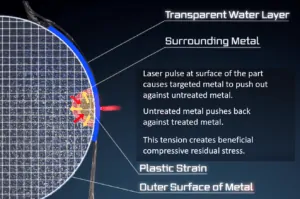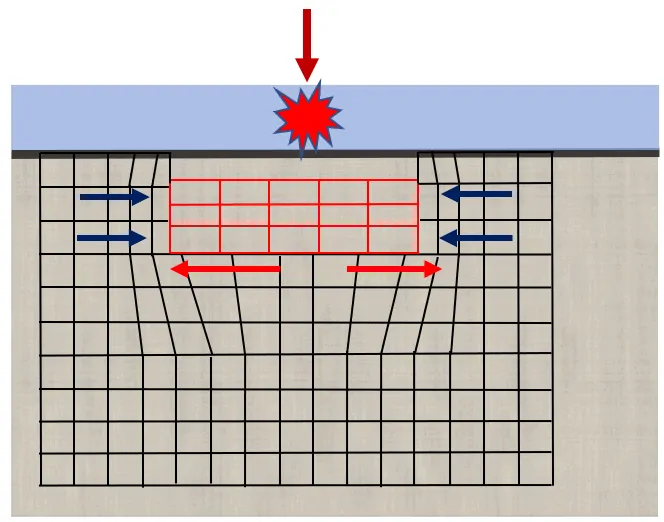Laser Peening vs. Laser Hardening
Both use lasers to improve metals, but in completely different ways. Laser Peening’s cold work adds to fatigue life by providing beneficial compressive stresses, countering corrosion and cracking. Laser Hardening, a heat treating process, focuses specifically on protecting against friction and wear.
Posted: November 9, 2020
By:

The goals and process of Laser Peening are completely different from Laser Hardening. Both can provide specialized benefits to metals, and both use lasers, but that is where their common characteristics diverge.
Laser Peening is a cold work process, but Laser Hardening is a heat treating process, often generating temperatures of more than 1,000 degrees centigrade.
Laser Peening uses short-pulse lasers – lasting about 8-16 nanoseconds long at each spot. But Laser Hardening moves a continuous beam around the part – or the part moves to absorb heat from a stationary beam.
Most important, the benefits from the two processes are almost completely different.
Laser Hardening, often called Laser Case Hardening, primarily seeks to harden metals against friction, abrasive materials, and wear.
Laser Peening, on the other hand, adds to the useful life, or fatigue life, of metals, preventing damage from corrosion, cracking, and high-cycle vibration in mechanical parts.
Laser Peening
Objective
Longer fatigue life
Laser Operation
Laser applied to targeted areas
The Science
Pressure wave created by the laser pulse penetrates deep into the metal, inducing compressive residual stress, counteracting harmful tensile stresses that lead to corrosion and cracking.
Chief Benefits
Up to 10x fatigue life of untreated metals, particularly effective at arresting and preventing corrosion, cracking and cyclic metal fatigue.
Protection
- Up to 12 millimeters, 10x as deep as most conventional treatments, including both laser hardening and shot peening.
- Protects against corrosion, cracking, foreign object damage, pressurized water stress corrosion cracking, fretting, galling, cavitation, embrittlement, microstructural porosity.
- Cold process providing deep, long-lasting protection against wide range of metal fatigue issues.
Laser Hardening
Objective
Hardening to resist wear
Laser Operation
Continuous laser beam moves over surface
The Science
The laser heats the metal surface, followed by rapid quenching, forming a martensitic structure, the thin case layer at the surface that protects metal underneath.
Chief Benefits
Helps prevent plastic deformation of metal parts due to sliding contact with other materials or abrasive materials for more wear-resistant surfaces.
Protection
- Up to 01 to 2 millimeters below the surface, either across the entire surface or selectively parts of the surface.
- Prevents wear and adds some compressive residual stresses
- Increases hardening and resistance to wear without adding to brittleness or warping of metal shapes

See How Laser Peening Works for an in-depth discussion of the process and a new video with slow-motion and close-up views of the process.
Laser peening, often referred to as Laser Shock Peening (hence the LSP in LSP Technologies), sends a wave of pressure deep into metals to create compressive residual stresses. These mechanical stresses prevent corrosion, cracking, and other symptoms of metal fatigue, often extending the life of metal components by 10 to 15 times their normal useful life.
The Laser Hardening Process
Laser hardening is a hot process, using extremely high temperatures to alter the crystal structure of metals. Laser hardening involves heating metals almost to their melting point, typically between 900 and 1400 degrees centigrade, which rearranges carbon atoms in a process called austenization.
A crystal structure called martensite forms, which has physical hardening properties that penetrate as much as 2 millimeters into the metal. The surrounding cooler metal quenches the treated metal after laser heating. This heating/quenching action provides the protective “case” around the metal. That hardening prevents plastic deformation of the metal.
“As we are getting more and more interest in laser peening, our customers want to know how it’s different from other processes, like laser hardening and shot peening [link to Laser peening vs. shot peening page],” said Eric Collet, Chief Operating Officer of LSP Technologies.

“For one thing, the benefits of laser peening penetrate up to 12 millimeters beneath the metal surface, whereas shot peening and laser hardening max out at less than one-tenth of that depth,” he said. “There are a number of metal treatments for hardening against wear and friction, including laser hardening, but they usually involve extreme high-temperature heat treating.”
Laser peening uses short pulses to create a pressure wave that provides beneficial compressive residual stresses deep into the part.
That compressive stress counteracts harmful tensile stresses.. On industrial parts, laser peening prevents – and arrests — corrosion, cracking, and damage from foreign objects, like birds and debris that pose a hazard for jet engine blades.
Carbon Content and Laser Hardening
Laser Hardening works best on high-carbon steels, with at least 0.45 percent carbon, and the less carbon present, the lower the hardening benefits.
But any metal can benefit from Laser Peening, regardless of carbon content. Aluminum, Titanium, Carbon Steel all see improvements in situations where deep compressive residual stresses can protect the component from fatigue failure, cracking, corrosion, and damage from high cycle vibration.

In laser peening, a laser pulse generates a shock wave that mechanically stretches affected material. The surrounding material tries to push back to its previous state, compressing against the treated material, creating beneficial compressive residual stress.
Interested in Seeing More?
Tell us about your application, material, or failure mechanism and we will have one of our experts reach out to you. Our extensive library of research and years of experience gives us a unique advantage to apply a finite element analysis to help diagnose the best application for your situation.
